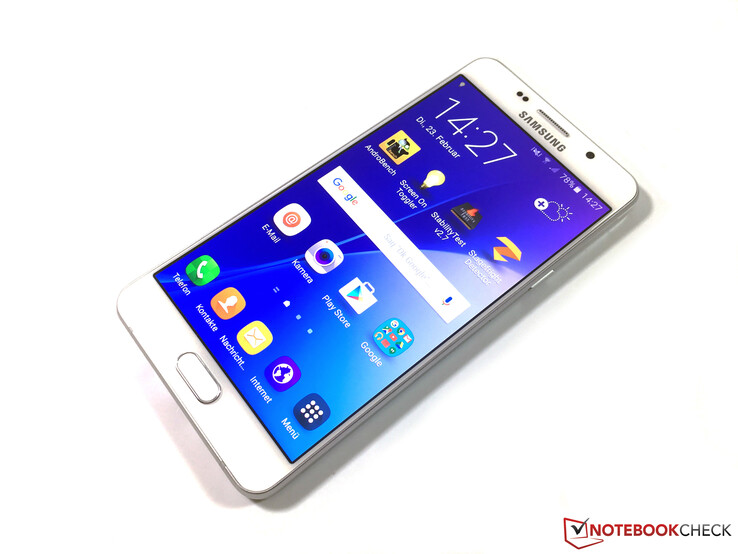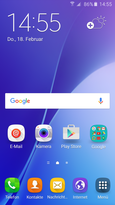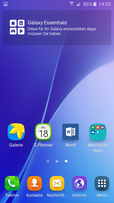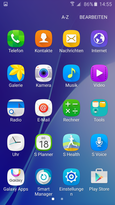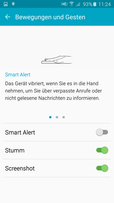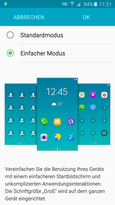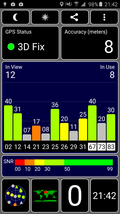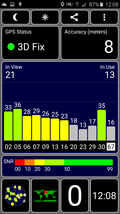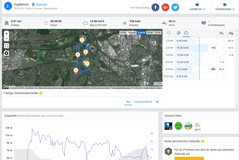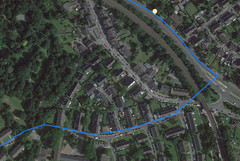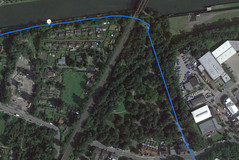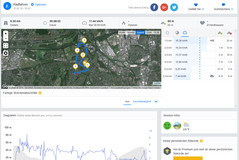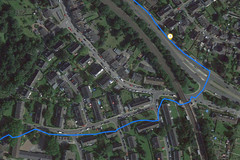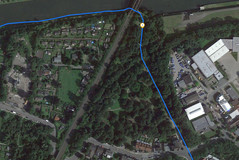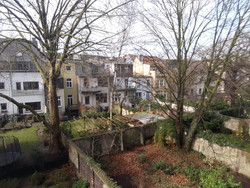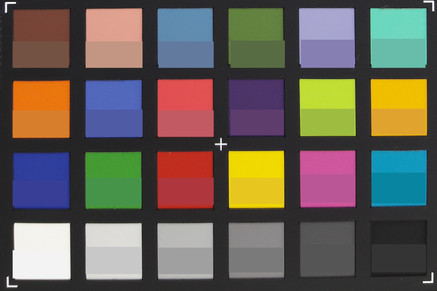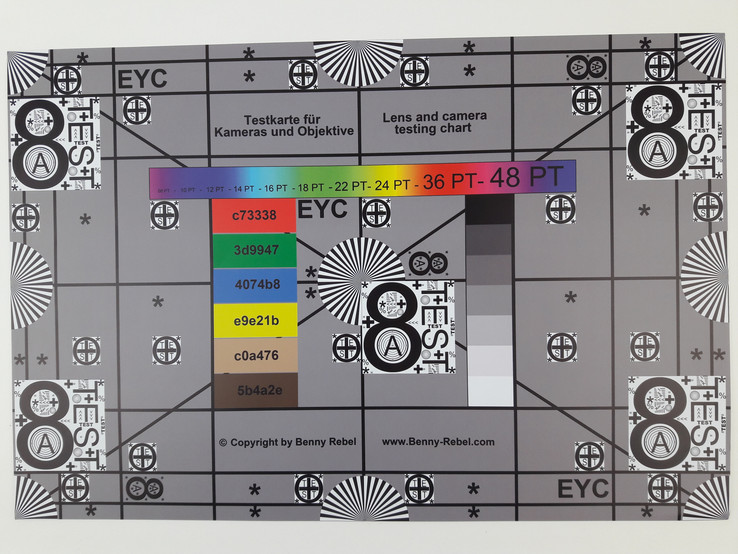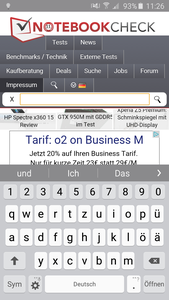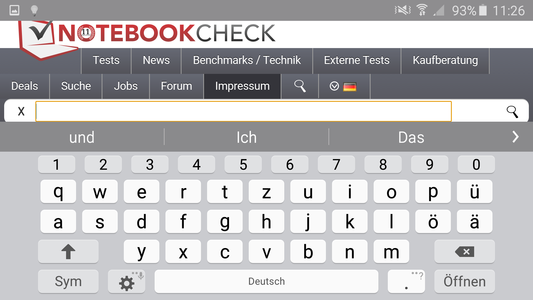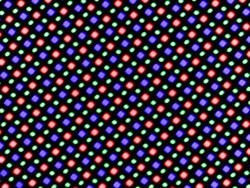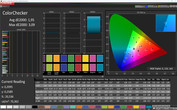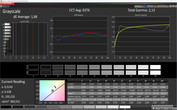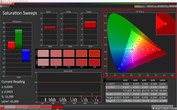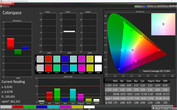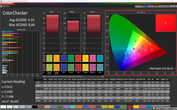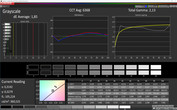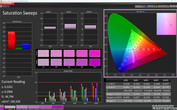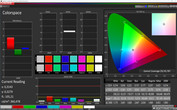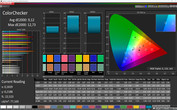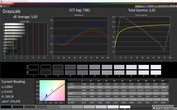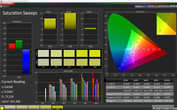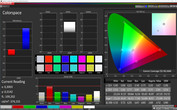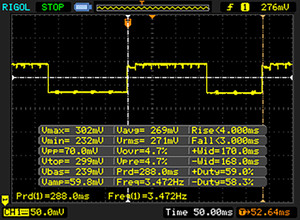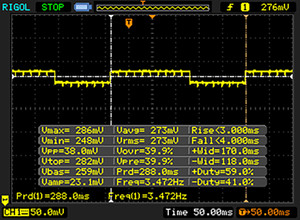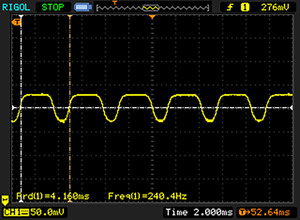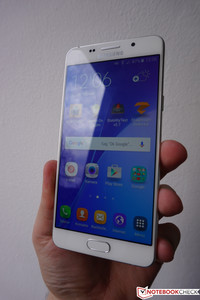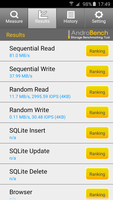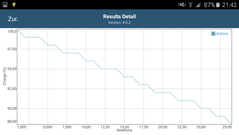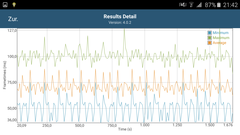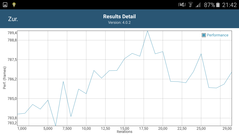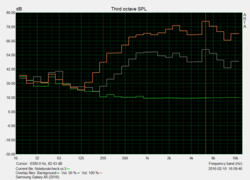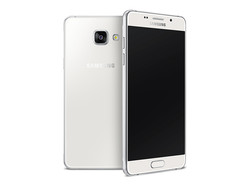Samsung Galaxy A5 (2016) Smartphone Review
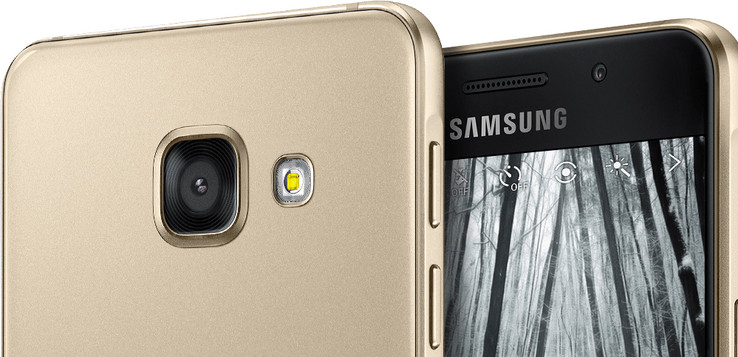
For the original German review, see here.
Samsung's newest Galaxy A5 (2016) is a consistent further development of the predecessor. Again, the smartphone's focus is on design with its casing composed of aluminum and glass. The battery still cannot be removed, but the storage capacity can be expanded via micro-SD card. The buyer again gets solid mid-range components alongside an Exynos octa-core SoC, Super-AMOLED screen in Full HD resolution and a fingerprint scanner in total. The technical relationship to the Galaxy S5 Neo (approx. 100 Euros, ~$108, cheaper) that we had in review is interesting.
Starting at an official retail price of 429 Euros (~$466), the latest Galaxy A5 finds many opponents. We use the Nexus 5X, HTC One A9, Huawei P8 and OnePlus 2 as comparison devices for this test. However, Samsung also provides two strong rivals: In addition to the aforementioned Galaxy S5 Neo, the price of the former top-model Galaxy S6 has dropped considerably and is now not much more expensive than the Galaxy A5.
Case
Like the predecessor, the casing of Samsung's Galaxy A5 is made of aluminum and glass. This time, glass is also used on the back. However, that makes it feel very sleek and sometimes even a bit slippery. The camera only juts out of the back marginally and is therefore not annoying in everyday use. The aluminum bezel is slightly beveled at the edges. The design is overall very appealing, but the sleek, glass back makes handling a bit awkward. The keys are incorporated very accurately, but the Home button produces a relatively loud clicking noise. The Galaxy A5 (2016) is available in black, gold and pink-gold in addition to our white review sample.
The stiffness of the unibody casing is very good. We only heard very quiet cracking noises during very energetic warping attempts. Pressure on the screen is not at all a problem. In total, the entire build can be called impeccable.
Compared with the predecessor, this year's A5 is a bit taller (6.7 vs. 7.3 mm). It is still pleasant to hold with a weight of 155 grams. The devices in the comparison are all on a very similar level. Only OnePlus' 2 is noticeably bulkier with its bigger 5.5-inch display. The battery cannot be removed due to the casing's construction.
Connectivity
The Exynos 7580 octa-core SoC operates with eight cores, and 2 GB of working memory supports it. The internal storage capacity is 16 GB. The user can initially use 10.8 GB, but 1 GB is additionally deducted from that after updating the preloaded apps. The storage can be expanded by up to 128 GB via a micro-SD card. Compatible apps can be moved to the memory card after their installation. A micro-USB 2.0 port for charging and data sharing with a PC is situated on the lower edge; it also supports USB-OTG for external peripherals, but not MHL. Supported transfer standards are Wi-Fi Direct and ANT besides NFC and Bluetooth 4.1. An FM radio that can be used in conjunction with headphones is also integrated.
The fingerprint scanner is incorporated into the Home button. The finger has to be placed on the sensor 10 - 15 times for setting it up. It functions very reliably and conveniently since swiping is not necessary. However, the sensors in the rivals are now faster. The fingerprint can also be used for logging in on websites and making payments via the Samsung account (e.g. in Samsung's own apps store) after unlocking the screen. The fingerprint cannot yet be used for shopping in Google's Play Store.
Software
The Galaxy A5 is shipped with Android 5.1.1 that Samsung covers with its proprietary user interface TouchWiz. It is not yet known whether or when an update to the latest Android 6.0 Marshmallow will be released. Currently, only update information for the premium devices of the S and Note lineups are available, but not for the A models. The software does not present us with any big surprises. It is easy to use and offers some useful extra features, such as the news feed "Briefing" when swiping the home screen left. We also find the well-known extras like the proprietary app store "Galaxy Apps", "Smart Manager" and some Microsoft apps. The fitness tool "S-Health" that records daily activities via the integrated pedometer is also on-board.
Communication & GPS
Like the Galaxy S5 Neo, the Galaxy A5 supports the high-speed LTE Cat. 6 standard for transmission rates of up to 300 Mbit/s downstream (50 Mbit/s upstream) - at least when the provider supports these speeds. A version with dual-SIM support is available in some parts of the world. Only one SIM card can be inserted in the European A-510F model. All frequencies are listed in the specifications at the beginning of this article. The review sample is not quite as modern in local network connectivity. It does not support the high-speed 802.1ac standard. At least, both the 2.4 and 5 GHz networks can be used. We did not have any reception issues in either the urban German Telecom network or in the private Wi-Fi network at home during the test.
The European smartphone model can be localized via GPS and the Russian GLONASS systems. Tracking was already possible near a window indoors with a relatively good accuracy of 8 meters. The accuracy does not improve outdoors. Interestingly, the GPS signal decreases gradually until it is completely lost when a finger is placed on the smartphone's upper right.
We additionally check the tracking accuracy on a bike trip and compare the outcomes with the Garmin Edge 500 navigation system. Although the navigation system does not always track the route perfectly, the review sample takes bigger shortcuts since the position is not determined as frequently. The total deviation is only approximately 150 meters on our test route, thus there should not be any restrictions when navigating in a car.
Telephone & Call Quality
The phone app is known from other Samsung devices and should not be an unsolvable riddle for anyone. Phone numbers can be entered either via the large keypad or simply by opening the contact. It is also possible to set up call forwarding or block specified numbers in the settings.
We criticized the middling call quality in the test of the predecessor; in particular the microphone did not make a good impression. We were therefore curious whether the latest Galaxy A5 does a better job. The speaker still renders voices with some distortion, but our contact always understood us well. We did not observe static or other interruptions during calls.
Cameras & Multimedia
At first glance, the camera equipment seems unchanged compared with the predecessor. Samsung still installs a 13 MP sensor on the rear and a 5 MP lens on the front. However, a bigger aperture is now used in both modules (rear: f/1.9 vs. f/2.0; front: f/1.9 vs. 2.2), which is to create brighter photos. That is particularly noticed with the front camera. A lot can still be recognized even in low residual light despite the lack of a flash, even if that inevitably leads to image noise. The details also suffer under the low resolution, as can be seen in our comparison screenshot taken with the rear camera. Videos can be recorded in Full HD (1920x1080 pixels). In total, the performance is sufficient for selfies.
The camera app is very clearly arranged and easy to use. It offers common features, such as a professional mode and panorama mode, but it does not offer time lapse. Double clicking the home button directly opens the camera from standby, and the volume control keys serve as the release. The auto-focus has room for improvement: Unlike other smartphones, it needs quite some time and thus makes a somewhat sluggish impression.
Compared with other smartphones, it is immediately noticed that the rear-facing 13 MP camera shoots relatively dark photos. Some small details are absorbed already in scene 1, although the outcome is acceptable seen on its own. It is more drastic in scene 2 where many details of the surroundings cannot be recognized at all. The object is still illuminated properly in the low-light scene (scene 3), and many details are visible. However, the image noise is more prominent than in the rivals. The video-recording settings are limited to resolution, where the user can select Full HD, HD or VGA. The frame rate frequency is limited to 30 FPS and slow motion is not supported. The sensor copes well with quick panning, and the shots can also be paused.
Color Accuracy & Sharpness
In addition to our standard test, we also examined the color accuracy and sharpness under controlled test conditions. The photos are shot in automatic mode, and it is not edited afterwards. The white balance is not manipulated, either.
We use X-Rite's ColorChecker Passport for the test. The original color is displayed in the lower part of each color. Some colors of the Galaxy A5 are somewhat paler, but the deviations are overall within limits.
We assess the image sharpness based on a photo of our test chart. The 100% image section is from the center and is relatively sharp thanks to the decent resolution. Lightly frayed outlines are only seen at the edges. We could see this minor fuzziness in the entire chart.
Accessories
The box of Samsung's Galaxy A5 contains a modular power supply (10 watts), a USB cable, a headset and the usual brochures. Samsung optionally offers diverse accessories on its homepage, such as generic items like headphones or external batteries, as well as special covers for the A5.
Warranty
A warranty period of 24 months is included.
Input Devices & Handling
Samsung's keyboard is enabled by default. An additional number bar is above the normal letters. It is a bit narrower than the latter. The keyboard also supports all common features, such as word suggestions, spelling correction and swiping that first has to be enabled in the settings. The touchscreen offers very good gliding qualities, and inputs are implemented reliably even at the edges. Like in the Galaxy S5 Neo, handling was sometimes accompanied with occasional lags or glitches. The touchscreen is also very sensitive, which occasionally resulted in incorrect inputs.
Display
Samsung has improved the Galaxy A5's screen compared to last year's model. A Super-AMOLED panel is again installed, but its resolution has been increased to 1920x1080 pixels. That leads to a pixel density of 424 PPI alongside the somewhat larger diagonal of 5.2-inches, which ensures extremely sharp images.
The screen also scores very decently in the brightness measurements. While the screen's average brightness on a pure white image is almost 380 cd/m², it climbs to a maximum of 472 cd/m² when bright and dark content is distributed evenly (APL50). Even a tremendously high 681 cd/m² is possible when the light sensor is enabled. Since the inherent design leads to a black level of 0 cd/m², the contrast ratio is also extremely high. In total, the Galaxy A5 outshines the AMOLED rivals with these rates, and can even compete with the best LC displays in terms of brightness. The minimum brightness is only 1.79 cd/m², which allows using the smartphone very comfortably even in dark environments.
| |||||||||||||||||||||||||
Brightness Distribution: 91 %
Center on Battery: 378 cd/m²
Contrast: ∞:1 (Black: 0 cd/m²)
ΔE Color 1.95 | 0.5-29.43 Ø5
ΔE Greyscale 1.86 | 0.57-98 Ø5.3
Gamma: 2.13
| Samsung Galaxy A5 2016 Mali-T720 MP2, 7580 Octa, 16 GB eMMC Flash | Google Nexus 5X Adreno 418, 808 MSM8992, 32 GB eMMC Flash | HTC One A9 Adreno 405, 617 MSM8952, 16 GB eMMC Flash | Huawei P8 Mali-T628 MP4, Kirin 930, 16 GB eMMC Flash | Samsung Galaxy S6 Mali-T760 MP8, Exynos 7420, 32 GB UFS 2.0 Flash | OnePlus 2 Adreno 430, 810 MSM8994, 64 GB eMMC Flash | Samsung Galaxy S5 Neo Mali-T720 MP2, 7580 Octa, 16 GB eMMC Flash | |
|---|---|---|---|---|---|---|---|
| Screen | 10% | -1% | -55% | -18% | -35% | -25% | |
| Brightness middle | 378 | 503 33% | 346 -8% | 453 20% | 335 -11% | 451 19% | 334 -12% |
| Brightness | 380 | 498 31% | 349 -8% | 439 16% | 345 -9% | 446 17% | 341 -10% |
| Brightness Distribution | 91 | 97 7% | 93 2% | 91 0% | 89 -2% | 90 -1% | 91 0% |
| Black Level * | 0.38 | 0.28 | 0.3 | ||||
| Colorchecker dE 2000 * | 1.95 | 2.09 -7% | 1.55 21% | 4.7 -141% | 2.51 -29% | 3.84 -97% | 2.84 -46% |
| Colorchecker dE 2000 max. * | 3.09 | ||||||
| Greyscale dE 2000 * | 1.86 | 2.12 -14% | 2.05 -10% | 5.03 -170% | 2.59 -39% | 3.97 -113% | 2.91 -56% |
| Gamma | 2.13 103% | 2.27 97% | 2.15 102% | 2.27 97% | 2.43 91% | 2.46 89% | 2.01 109% |
| CCT | 6376 102% | 6621 98% | 6267 104% | 7439 87% | 6424 101% | 7283 89% | 6432 101% |
| Contrast | 1324 | 1618 | 1503 | ||||
| Color Space (Percent of AdobeRGB 1998) | 72.04 | 58.07 | |||||
| Color Space (Percent of sRGB) | 90.14 |
* ... smaller is better
As common for Super-AMOLEDs, the user can select among different color profiles. The smartphone automatically adapts to content by default, but the profiles Basic, Cinema (higher saturation) and Photo (realistic reproduction) are also available. In delivery state, the average DeltaE 2000 shifts are a very good 1.95 in colors and 1.86 in the grayscale levels compared with the sRGB color space. The target rate is less than 3 in both cases, and thus the human eye will not detect any color shifts. That makes the Galaxy A5 one of the best devices also in the comparison field.
Display Response Times
| ↔ Response Time Black to White | ||
|---|---|---|
| 7 ms ... rise ↗ and fall ↘ combined | ↗ 4 ms rise | |
| ↘ 3 ms fall | ||
| The screen shows very fast response rates in our tests and should be very well suited for fast-paced gaming. In comparison, all tested devices range from 0.1 (minimum) to 240 (maximum) ms. » 16 % of all devices are better. This means that the measured response time is better than the average of all tested devices (21.5 ms). | ||
| ↔ Response Time 50% Grey to 80% Grey | ||
| 7 ms ... rise ↗ and fall ↘ combined | ↗ 3 ms rise | |
| ↘ 4 ms fall | ||
| The screen shows very fast response rates in our tests and should be very well suited for fast-paced gaming. In comparison, all tested devices range from 0.2 (minimum) to 636 (maximum) ms. » 15 % of all devices are better. This means that the measured response time is better than the average of all tested devices (33.7 ms). | ||
Screen Flickering / PWM (Pulse-Width Modulation)
| Screen flickering / PWM detected | 240.4 Hz | ||
The display backlight flickers at 240.4 Hz (worst case, e.g., utilizing PWM) . The frequency of 240.4 Hz is relatively low, so sensitive users will likely notice flickering and experience eyestrain at the stated brightness setting and below. In comparison: 53 % of all tested devices do not use PWM to dim the display. If PWM was detected, an average of 17900 (minimum: 5 - maximum: 3846000) Hz was measured. | |||
Thanks to the tremendous brightness (with enabled brightness sensor) and extremely high contrast ratio, the content displayed on the Galaxy A5 remains easily legible even in bright surroundings. We could not make a photo in direct sunlight due to weather conditions, but that should not be a problem. That is, of course, providing reflections on the glare-type screen are avoided, as is the case in virtually every mobile device. The right description for the viewing-angle stability is also excellent: minor color shifts (greenish tint) are only seen in extreme positions. That will not restrict everyday use, though.
Performance
The SoC in Samsung's Galaxy A5 is the Exynos 7580 Octa. As the name suggests, it has eight Cortex A53 cores that achieve a maximum of 1.6 GHz. The processor is a member of the lower mid-range in terms of performance and thus it has a hard time in this comparison. That is all the more true for the Mali-T720 MP2 graphics card with a performance even lower than Qualcomm's Adreno 405.
We find the expected results in the benchmarks. Our review sample is usually in one of the last places and competes with the technically very identical Galaxy S5 Neo for the last place. Both Samsung devices are clearly behind the rivals particularly in the graphically demanding Sling Shot benchmark (ES 3.0). In total, the Galaxy A5, Galaxy S5 Neo, Huawei P8 as well as HTC One A9 are on par. We would have wished for a bit more power in view of the purchase price.
| Geekbench 3 | |
| 32 Bit Multi-Core Score (sort by value) | |
| Samsung Galaxy A5 2016 | |
| Huawei P8 | |
| Samsung Galaxy S6 | |
| OnePlus 2 | |
| Samsung Galaxy S5 Neo | |
| 32 Bit Single-Core Score (sort by value) | |
| Samsung Galaxy A5 2016 | |
| Huawei P8 | |
| Samsung Galaxy S6 | |
| OnePlus 2 | |
| Samsung Galaxy S5 Neo | |
| 64 Bit Multi-Core Score (sort by value) | |
| Google Nexus 5X | |
| HTC One A9 | |
| Huawei P8 | |
| OnePlus 2 | |
| 64 Bit Single-Core Score (sort by value) | |
| Google Nexus 5X | |
| HTC One A9 | |
| Huawei P8 | |
| OnePlus 2 | |
| AnTuTu v5 - Total Score (sort by value) | |
| Samsung Galaxy A5 2016 | |
| Google Nexus 5X | |
| HTC One A9 | |
| Huawei P8 | |
| Samsung Galaxy S6 | |
| OnePlus 2 | |
| Samsung Galaxy S5 Neo | |
| AnTuTu v6 - Total Score (sort by value) | |
| Samsung Galaxy A5 2016 | |
| OnePlus 2 | |
| GFXBench (DX / GLBenchmark) 2.7 | |
| T-Rex Onscreen (sort by value) | |
| Samsung Galaxy A5 2016 | |
| Google Nexus 5X | |
| HTC One A9 | |
| Huawei P8 | |
| Samsung Galaxy S6 | |
| OnePlus 2 | |
| Samsung Galaxy S5 Neo | |
| 1920x1080 T-Rex Offscreen (sort by value) | |
| Samsung Galaxy A5 2016 | |
| Google Nexus 5X | |
| HTC One A9 | |
| Huawei P8 | |
| Samsung Galaxy S6 | |
| OnePlus 2 | |
| Samsung Galaxy S5 Neo | |
| GFXBench 3.0 | |
| on screen Manhattan Onscreen OGL (sort by value) | |
| Samsung Galaxy A5 2016 | |
| Google Nexus 5X | |
| HTC One A9 | |
| Huawei P8 | |
| Samsung Galaxy S6 | |
| OnePlus 2 | |
| Samsung Galaxy S5 Neo | |
| 1920x1080 1080p Manhattan Offscreen (sort by value) | |
| Samsung Galaxy A5 2016 | |
| Google Nexus 5X | |
| HTC One A9 | |
| Huawei P8 | |
| Samsung Galaxy S6 | |
| OnePlus 2 | |
| Samsung Galaxy S5 Neo | |
The browser benchmarks are performed with Samsung's preloaded browser that is based on Chrome 38. The four models mentioned above are again on a similarly low level and clearly lag behind the Galaxy S6, Nexus 5X and OnePlus 2. Minor glitches might also be observed in everyday Internet browsing on more complex pages.
| Octane V2 - Total Score (sort by value) | |
| Samsung Galaxy A5 2016 | |
| Google Nexus 5X | |
| HTC One A9 | |
| Huawei P8 | |
| Samsung Galaxy S6 | |
| OnePlus 2 | |
| Samsung Galaxy S5 Neo | |
| Mozilla Kraken 1.1 - Total (sort by value) | |
| Samsung Galaxy A5 2016 | |
| Google Nexus 5X | |
| HTC One A9 | |
| Huawei P8 | |
| OnePlus 2 | |
| Samsung Galaxy S5 Neo | |
| JetStream 1.1 - Total Score (sort by value) | |
| Samsung Galaxy A5 2016 | |
| Google Nexus 5X | |
| HTC One A9 | |
| Samsung Galaxy S6 | |
| OnePlus 2 | |
| Samsung Galaxy S5 Neo | |
| WebXPRT 2015 - Overall (sort by value) | |
| Samsung Galaxy A5 2016 | |
| Google Nexus 5X | |
| HTC One A9 | |
| Huawei P8 | |
| OnePlus 2 | |
| Samsung Galaxy S5 Neo | |
* ... smaller is better
The 16 GB eMMC storage is likely the same model as in the Galaxy S5 Neo since the benchmark scores are virtually identical. Almost 210 MB/s in sequential read and 60 MB/s in sequential write place the Galaxy A5 in the midfield. That should not restrict everyday use.
We also test the card reader's performance with our Toshiba Exceria SD-CX32UHSI (32 GB) reference card. The rates are a very good 80 MB/s (read) and 40 MB/s (write). Thus, nothing stands in the way of using a micro-SD card for expanding the storage.
| BaseMark OS II - Memory (sort by value) | |
| Samsung Galaxy A5 2016 | |
| Google Nexus 5X | |
| HTC One A9 | |
| Huawei P8 | |
| OnePlus 2 | |
| Samsung Galaxy S5 Neo | |
Games
The review sample's higher screen resolution leads to even worse outcomes than that of the Galaxy S5 Neo in this section. For example, the Mali-T720 MP2 could not render the demanding racing game Asphalt 8: Airborne really smoothly using low graphics settings. That was first possible in very low details. Minor stutters were also observed in the more basic Angry Birds 2, for example in explosions. The sensors function well. However, the hand quickly covers the speaker in landscape mode.
| Asphalt 8: Airborne | |||
| Settings | Value | ||
| very low | 29 fps | ||
| Dead Trigger 2 | |||
| Settings | Value | ||
| high | 34 fps | ||
Emissions
Temperature
The Galaxy A5's temperature development is absolutely uncritical. Some comparison devices are even a bit cooler, but the review sample never gets unpleasant with a maximum of almost 36 °C on the upper side even under load. The smartphone's underside, where the hand usually is, remains even cooler.
There are no temperature issues with the SoC inside and consequently no issues with the performance. The GFXBench battery test repeats the T-Rex test 30 times and records the performance. Although the performance flow looks a bit adventurous, the fluctuations are within just 1%.
(+) The maximum temperature on the upper side is 35.9 °C / 97 F, compared to the average of 35 °C / 95 F, ranging from 21.9 to 56 °C for the class Smartphone.
(+) The bottom heats up to a maximum of 33.8 °C / 93 F, compared to the average of 33.8 °C / 93 F
(+) In idle usage, the average temperature for the upper side is 31.9 °C / 89 F, compared to the device average of 32.7 °C / 91 F.
| Samsung Galaxy A5 2016 Mali-T720 MP2, 7580 Octa, 16 GB eMMC Flash | Google Nexus 5X Adreno 418, 808 MSM8992, 32 GB eMMC Flash | HTC One A9 Adreno 405, 617 MSM8952, 16 GB eMMC Flash | Huawei P8 Mali-T628 MP4, Kirin 930, 16 GB eMMC Flash | Samsung Galaxy S6 Mali-T760 MP8, Exynos 7420, 32 GB UFS 2.0 Flash | OnePlus 2 Adreno 430, 810 MSM8994, 64 GB eMMC Flash | Samsung Galaxy S5 Neo Mali-T720 MP2, 7580 Octa, 16 GB eMMC Flash | |
|---|---|---|---|---|---|---|---|
| Heat | 6% | -3% | 5% | 4% | -23% | 9% | |
| Maximum Upper Side * | 35.9 | 34.4 4% | 41.3 -15% | 35.7 1% | 35.6 1% | 45.8 -28% | 33.5 7% |
| Maximum Bottom * | 33.8 | 37.4 -11% | 39.8 -18% | 31.3 7% | 35.9 -6% | 43.5 -29% | 34 -1% |
| Idle Upper Side * | 32.8 | 28.2 14% | 28.7 12% | 33.2 -1% | 29.4 10% | 38.9 -19% | 27.8 15% |
| Idle Bottom * | 31.5 | 25.8 18% | 28.4 10% | 27.6 12% | 28.6 9% | 36.9 -17% | 27.4 13% |
* ... smaller is better
Speaker
In this chapter, another modification compared with the predecessor is found. The mono speaker is now situated on the lower edge and no longer on the back. Thus, the smartphone can be placed on a table without needing to fear a muffled sound. The sound is overall tinny and bass is absolutely non-existent. At least only minor distortions are heard in high volumes. The maximum volume of almost 88 dB(A) is also sufficiently high. Samsung's SoundAlive music app offers some presets and settings to adapt the audio output according to personal preferences. Connecting external speakers or headphones would be recommendable for a better sound. That functioned impeccably via both the 3.5 mm jack and Bluetooth.
Energy Management
Power Consumption
Different instruments were used for the comparison measurements in some cases, and thus not all devices are directly comparable. We could, however, compare the Galaxy A5 directly with the technically very similar Galaxy S5 Neo that needs more power despite its screen's slightly smaller size and considerably lower resolution, particularly in idle. The review sample is also very frugal with at most 5 watts during load, which is due to the comparatively low performance.
Samsung ships the Galaxy A5 with a modular 10-watt power supply that supports Quick Charge. The battery is recharged by 50% in a bit over half an hour. The battery needs approximately 1 hour and 40 minutes for a full recharge.
| Off / Standby | |
| Idle | |
| Load |
|
| Samsung Galaxy A5 2016 Mali-T720 MP2, 7580 Octa, 16 GB eMMC Flash | Google Nexus 5X Adreno 418, 808 MSM8992, 32 GB eMMC Flash | HTC One A9 Adreno 405, 617 MSM8952, 16 GB eMMC Flash | Huawei P8 Mali-T628 MP4, Kirin 930, 16 GB eMMC Flash | Samsung Galaxy S6 Mali-T760 MP8, Exynos 7420, 32 GB UFS 2.0 Flash | OnePlus 2 Adreno 430, 810 MSM8994, 64 GB eMMC Flash | Samsung Galaxy S5 Neo Mali-T720 MP2, 7580 Octa, 16 GB eMMC Flash | |
|---|---|---|---|---|---|---|---|
| Power Consumption | -12% | 1% | -26% | 10% | -16% | -40% | |
| Idle Minimum * | 0.96 | 0.55 43% | 0.9 6% | 0.7 27% | 0.4 58% | 0.6 37% | 1.68 -75% |
| Idle Average * | 1.64 | 1.44 12% | 1.2 27% | 2 -22% | 0.6 63% | 1.7 -4% | 2.2 -34% |
| Idle Maximum * | 1.71 | 1.9 -11% | 1.4 18% | 2.1 -23% | 1.2 30% | 1.8 -5% | 2.33 -36% |
| Load Average * | 2.98 | 3.36 -13% | 3.8 -28% | 4.9 -64% | 5 -68% | 5.7 -91% | 4.09 -37% |
| Load Maximum * | 5.08 | 9.76 -92% | 5.9 -16% | 7.4 -46% | 6.8 -34% | 6 -18% | 5.92 -17% |
* ... smaller is better
Battery Runtime
Samsung installs a 2900 mAh battery that achieves very good battery runtimes in conjunction with the low consumption rates. Over 38 hours is possible in an ideal case (Wi-Fi read script, minimum brightness). However, the load rate is all the more impressive (maximum brightness, Stability test). The user can count with approximately 8 hours before the battery is depleted even in a worst-case scenario. The outcomes in the tests using a brightness set to approximately 150 cd/m² are also very good. 10.5 hours in the Wi-Fi test and over 11 hours when rendering a Full HD video (Big Buck Bunny, H.264) place the Galaxy A5 before the comparison devices. Only the Galaxy S5 Neo is a bit more enduring in video playback. The review sample easily lasted a whole day in real-world use.
The familiar energy-saving modes are again integrated. In addition to the standard mode that limits the CPU's performance and brightness, the Ultra Energy Saving mode is also present. However, it strongly limits the smartphone's functions and only offers a gray-scale view. Regardless of the selected mode, the screen's brightness decreases to minimum at a battery charge of below 5% and cannot be increased.
| Samsung Galaxy A5 2016 Mali-T720 MP2, 7580 Octa, 16 GB eMMC Flash | Google Nexus 5X Adreno 418, 808 MSM8992, 32 GB eMMC Flash | HTC One A9 Adreno 405, 617 MSM8952, 16 GB eMMC Flash | Huawei P8 Mali-T628 MP4, Kirin 930, 16 GB eMMC Flash | Samsung Galaxy S6 Mali-T760 MP8, Exynos 7420, 32 GB UFS 2.0 Flash | OnePlus 2 Adreno 430, 810 MSM8994, 64 GB eMMC Flash | Samsung Galaxy S5 Neo Mali-T720 MP2, 7580 Octa, 16 GB eMMC Flash | |
|---|---|---|---|---|---|---|---|
| Battery Runtime | -31% | -47% | -41% | -37% | -38% | -11% | |
| Reader / Idle | 2323 | 1775 -24% | 1154 -50% | 826 -64% | 1300 -44% | 1393 -40% | 1615 -30% |
| H.264 | 672 | 555 -17% | 465 -31% | 581 -14% | 580 -14% | 773 15% | |
| WiFi v1.3 | 626 | 412 -34% | 368 -41% | 434 -31% | 475 -24% | 356 -43% | 546 -13% |
| Load | 483 | 245 -49% | 176 -64% | 215 -55% | 278 -42% | 229 -53% | 402 -17% |
| WiFi | 575 |
Pros
Cons
Verdict
Samsung's Galaxy A5 (2016) proves to be a successful advancement of the predecessor in most sectors. The mid-range smartphone is again very elegant and, apart from PWM flickering, it has one of the best panels in this segment. The cameras have also been improved slightly. Further plus points are the low emissions and long battery life.
Real shortcomings are not found. We would have wished for ac Wi-Fi, and the casing is quite slippery due to its glass back, which lessens the good overall impression to a small extent. However, the biggest issue is - like in the predecessor - the performance. At an RRP of 429 Euros (~$466), we would have hoped for a bit more power. The Galaxy A5 not only falls behind its opponents in the benchmarks, but small lags and glitches are also noticed time and again in everyday use. Whether or not the mid-range models from the A lineup will be updated to Android 6.0 is not yet known, either.
Samsung again provides a very high-quality as well as very pricey mid-range smartphone with its new Galaxy A5. The screen belongs to the best of its kind, but it lags behind its rivals in performance.
Samsung Galaxy A5 2016
-
02/26/2016 v5(old)
Andreas Osthoff


 Deutsch
Deutsch English
English Español
Español Français
Français Italiano
Italiano Nederlands
Nederlands Polski
Polski Português
Português Русский
Русский Türkçe
Türkçe Svenska
Svenska Chinese
Chinese Magyar
Magyar